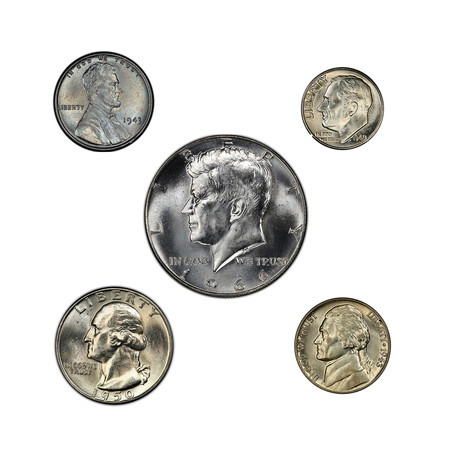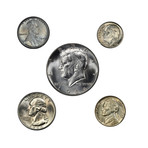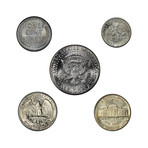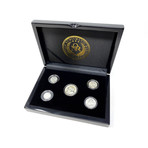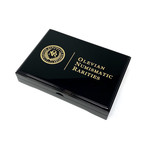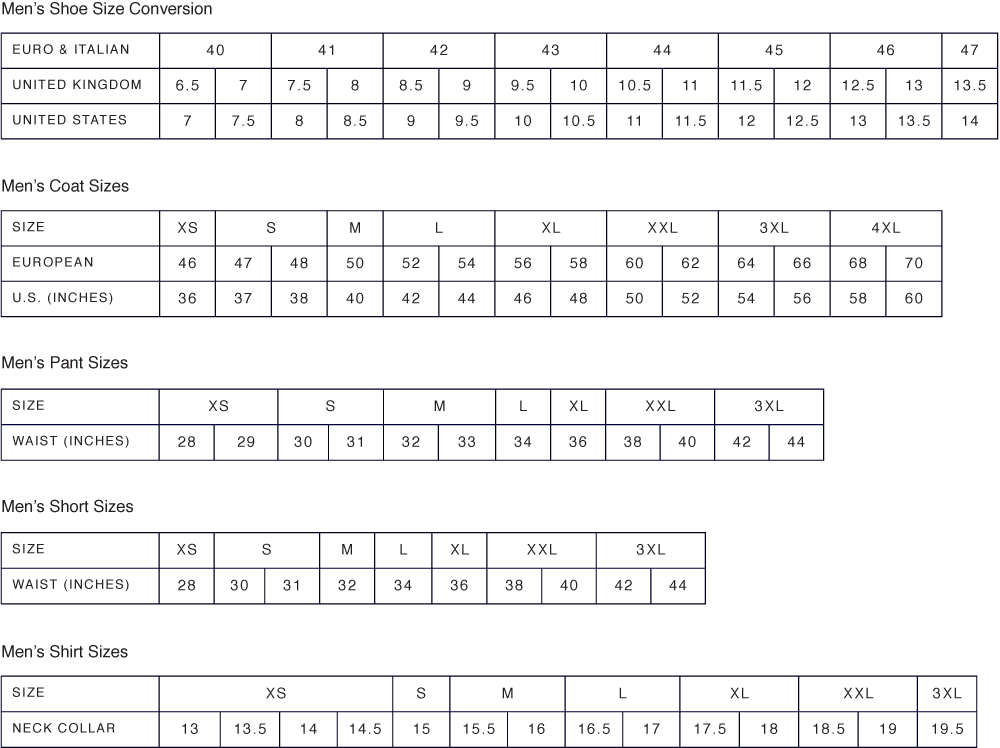Olevian Numismatic Rarities
United States Silver Presidential 5-Coin Set // American Classics Series // Wood Presentation Box
Product Description
This vintage 20th century set features 5 different coins that honor past U.S. presidents, including the Abraham Lincoln cent, Thomas Jefferson nickel, Franklin D. Roosevelt dime, George Washington quarter, and John F. Kennedy half dollar. The coins in this collection were hand-selected by professional numismatists after screening thousands of coins for quality and eye-appeal. Each of the 4 largest denominations were minted using a silver alloy. No cents were ever struck in silver, but the 1943 steel cent issued during WWII is the only cent with a similar appearance. Due to rising bullion prices, silver was removed entirely from all circulating coins after 1970, rendering the coins in this collection relics of a bygone era in American history. Each coin is housed in an airtight capsule and the set is presented in a luxurious, plush-lined wood box with embossed metallic gold lettering, piano-black finish, and certificate of authenticity. The coins are unconditionally guaranteed to be genuine, dated between 1932 and 1970, and will match the quality of the ones shown.
The Lincoln cent is an enduring American classic produced for the past 112 years, making it the longest running United States coin design in existence, albeit with modification. In 1905, famed sculptor Augustus Saint-Gaudens was hired by the Mint at the request of President Roosevelt to beautify the nation’s coinage. Although Saint-Gaudens successfully redesigned the $10 and $20 gold pieces, he died in 1907 before he could submit designs for the new cent. Consequently, the Mint commissioned Victor D. Brenner in January of 1909 to design a one cent coin honoring Abraham Lincoln on the centennial of his birth. This marked the first widely circulating U.S. coin to feature the likeness of a President, as this concept had previously been considered too monarchical, particularly by George Washington. The obverse featured a bust of Lincoln, while the reverse depicted two stalks of wheat, representing staples of the U.S. economy, flanking the denomination. Brenner’s revolutionary design was approved, and the new coins were released to the public on August 2nd, 1909 with much fanfare. Like the outgoing Indian cent, the new Lincoln cent was composed primarily of copper. However, copper became a critical military resource during World War II, so the U.S. government decided to divert the copper reserves used for manufacturing Lincoln cents to aid the war efforts. At the height of the war in 1943 and with no better options, the U.S. Mint decided to produce the one cent coin in a zinc-plated steel composition as an emergency measure for one year only, with resumption of the ordinary copper composition in 1944. The Lincoln cent continued to feature the wheat stalk reverse until the sesquicentennial of Lincoln’s birth in 1959, at which point a new reverse depicting the Lincoln Memorial was introduced. This set includes a WWII emergency-issue 1943 Lincoln cent struck in zinc-plated steel.
Thomas Jefferson was a man of many talents. He is best known as the principle author of the Declaration of Independence and third president of the United States from 1801 to 1809. Jefferson’s achievements as an architect, statesman, scientist, and philosopher have earned him a lasting legacy as one of the truly great figures in American history. It is no surprise that his likeness eventually appeared on circulating U.S. coinage in 1938 and has continued to do so for over 80 years. The Jefferson nickel was designed by German-American sculptor Felix Schlag, who was awarded a $1,000 prize in April of 1938 when his model was selected among those submitted by 390 contestants. Schlag’s portrait of Jefferson was based on a marble bust by famed French sculptor Jean-Antoine Houdon. The Jefferson nickel features the left-facing president dressed in a coat of the period and wearing a peruke wig. On the reverse is a front elevation of Jefferson’s home, with the name MONTICELLO beneath it. The novelty of the Jefferson Nickel caused most examples to be saved by a curious public during its first few years, and the coin was not a familiar sight in circulation until about 1940. Shortly thereafter, the onset of World War II prompted the rationing of many commodities, including nickel, which was highly valued for use in armor plating. Congress ordered the removal of this metal from the five-cent piece, effective October 8, 1942. From that date until the end of 1945, five-cent pieces bore the regular design but were minted from an alloy of silver, copper, and manganese. These emergency coins were to be withdrawn from circulation after the war, so a prominent distinguishing feature was added. Coins from all three mints bore large mintmarks above the dome of Monticello, and the letter ‘P’ was used as a mintmark for Philadelphia for the first time. These “war nickels” proved quite satisfactory in circulation and were not immediately withdrawn. Instead, they remained a familiar sight until the mid-1960s, when rising silver prices caused them to be hoarded for their bullion value. Jefferson nickel production continues today in its original 1938 composition, albeit with several design modifications in recent years to modernize our nation’s coinage. This set includes a WWII emergency-issue Jefferson nickel struck in silver between 1942 and 1945.
Franklin Delano Roosevelt served as the 32nd president of the United States from 1933 until 1945 and was the only president elected to 4 terms. A central figure in world events during the first half of the 20th century, Roosevelt died in office on April 12th, 1945, aged beyond his years by the twin burdens of the greatest economic depression in the nation’s history and the most devastating war of all time. As the country mourned its fallen leader, the American public was eager to memorialize Roosevelt in some significant way. Within the Treasury Department, plans were quickly laid for the introduction of a new coin to honor Roosevelt. Since the late president had been afflicted with polio, the dime was chosen to bear his portrait— a testament to the “March of Dimes” fundraising campaign to end Polio that began during Roosevelt’s first term. Straying from a 40-year tradition of enlisting outside artists, U.S. Mint Chief Engraver John R. Sinnock was appointed to design the new coin. The model ultimately chosen for production featured a large left-facing portrait of Roosevelt on the obverse, while the reverse featured an upright torch to symbolize freedom, flanked by branches of olive and oak, representing peace and victory. Notably, the small initials “JS” of the designer also appeared below Roosevelt’s portrait, which resulted in unexpected controversy shortly after the coin was released in 1946. With America newly concerned by the post-war threat of the Soviet Union, a rumor quickly spread that the initials JS were those of Soviet leader Joseph Stalin. As ludicrous as this may seem now, the U.S. Mint was forced to issue a statement identifying John Sinnock as the coin’s designer and dispelling any claims of a communist connection. The Roosevelt dime continued to be struck in silver every year, until rising bullion prices necessitated a compositional change to copper-nickel clad in 1965. Today, the Roosevelt dime enjoys widespread circulation and continues essentially unchanged in design since its introduction over 70 years ago. This set includes an early example of the Roosevelt dime struck in silver between 1946 and 1964.
As the dark shadow of economic depression fell across the United States in 1931, there was extraordinarily little to celebrate. However, one opportunity did present itself the following year: the 200th birthday of America’s first president. George Washington has been called the “Father of His Country” for his influential leadership in the formative days of the new nation. He led Patriot forces to victory during the Revolutionary War and later presided at the Constitutional Convention of 1787, which established the U.S. Constitution and a federal government. Washington then served that government as first president from 1789 to 1797. The Treasury Department had originally proposed that a half dollar be struck to honor Washington, but this was soon changed to the quarter when it was determined that replacing the half dollar would require congressional approval. A design by medalist John Flanagan was ultimately chosen, which featured an obverse depiction of Washington modeled after the famous bust created by French sculptor Jean Antoine Houdon. This bust was formed from a life-mask of Washington’s face taken at Mount Vernon in 1785 and is considered a highly accurate reproduction. The reverse of the coin features a bald eagle with outstretched wings clutching a bundle of arrows in its talons. Two olive branches of peace appear below. The Washington quarter was struck yearly in silver until rising bullion prices necessitated a compositional change to copper-nickel clad in 1965. For the nation’s bicentennial in 1976, a special reverse depicting a colonial drummer boy was issued and all coins featured the dual date of 1776-1976. The popularity of the Washington quarter amongst collectors has exploded in recent years, largely due to the introduction of the 50 State Quarters Program in 1999, which featured different reverses honoring each of the 50 states, 5 territories, and Washington, D.C. over an 11 year period. The America the Beautiful Quarters Program launched in 2010 showcases different National Park Service sites for each of 56 jurisdictions and will continue until 2021. This set includes an early example of the original Washington quarter design struck in silver between 1932 and 1964.
It has been said that every American alive in 1963 remembers exactly what he or she was doing the moment they heard that President Kennedy was assassinated. A profound sense of loss overtook the nation, which resulted in the renaming and dedication of numerous civic structures, roadways, airports, and geographical landmarks in honor of the fallen leader. Of all these memorials, however, one that may very well persist the longest is the Kennedy half dollar. Coins have existed for thousands of years and continue to be one of the most durable witnesses to human history. Within a few days of Kennedy’s tragic death, serious consideration was already underway to place the President’s portrait on a new silver coin. The plans were discussed with Mrs. Kennedy, who asked that her husband’s portrait not replace George Washington on the quarter. President Johnson requested that JFK’s portrait be employed on the half dollar that currently featured Benjamin Franklin. However, U.S. law stipulated that coin designs could not be changed more often than every 25 years and the Franklin half was then only 15 years old. A special act of Congress was needed, and on December 30th, 1963, Public Law 88-256 made the Kennedy half dollar a reality. The depiction of Kennedy that appeared on his inaugural medal was chosen for the obverse of the coin, one that Kennedy had personally approved. The presidential seal appearing on the same medal was chosen for the coin’s reverse. Production began in early 1964 and the coins were struck in 90% silver. On March 24th, Americans waited in line for hours at banks across the country to acquire the new coin but supplies quickly ran out. Mintage continued at enormous levels, yet few of the coins every achieved actual circulation. From its very inception, the Kennedy half dollar became a keepsake, cherished by generations of Americans. Due to rising silver costs, the composition of Kennedy half dollars was reduced to 40% silver in 1965 and eventually changed to copper-nickel clad in 1971. For the nation’s bicentennial in 1976, a special reverse depicting Independence Hall was issued and all coins featured the dual date of 1776-1976. Since 2002, Kennedy half dollars have only been struck in small quantities and sold to collectors at a premium. They are seldom encountered in circulation and have become one of the most widely collected coins in U.S. history. This set includes an early example of the Kennedy half dollar struck in 40% silver between 1965 and 1970.
Product Details
- Measurements
8"L x 6"W x 2"H
- OriginUnited States
Coin 1:
— Type: Lincoln Cent (1909- Present)
— Variety: Lincoln Wheat Cent (1909-1958), Zinc-plated Steel (1943)
— Designer: Victor David Brenner
— Weight: 2.70 grams
— Diameter: 19.00 mm
— Composition: Zinc-coated steel
— Obverse Design: Abraham Lincoln, facing right
— Obverse Inscription: LIBERTY / IN GOD WE TRUST / DATE
— Reverse Design: Wheat stalks flanking denomination
— Reverse Inscription: UNITED STATES OF AMERICA / E PLURIBUS UNUM / ONE CENT
Coin 2:
— Type: Jefferson Nickel (1932-Present)
— Variety: Silver (1942-1945)
— Designer: Felix Schlag
— Weight: 5.00 grams
— Diameter: 21.2 mm
— Composition: 0.560 copper, 0.350 silver, 0.090 manganese
— Net silver weight: 0.56260 troy ounces
— Obverse Design: Thomas Jefferson, facing left
— Obverse Inscription: IN GOD WE TRUST / LIBERTY / DATE
— Reverse Design: Monticello
— Reverse Inscription: UNITED STATES OF AMERICA / E PLURIBUS UNUM / FIVE CENTS
Coin 3:
— Type: Roosevelt Dime (1946-Present)
— Variety: Silver (1946-1964)
— Designer: John R. Sinnock
— Weight: 2.50 grams
— Diameter: 17.9 mm
— Composition: 0.900 silver, 0.100 copper
— Net silver weight: 0.07234 oz pure silver
— Obverse Design: Franklin Roosevelt, facing left
— Obverse Inscription: LIBERTY / IN GOD WE TRUST / DATE
— Reverse Design: Torch flanked by olive and oak branches
— Reverse Inscription: UNITE STATES OF AMERICA / E PLURIBUS UNUM / ONE DIME
Coin 4:
— Type: Washington Quarter (1932-Present)
— Variety: Silver (1932-1964)
— Designer: John Flanagan
— Weight: 6.30 grams
— Diameter: 24.3 mm
— Composition: 0.900 silver, 0.100 copper
— Net silver weight: 0.18084 oz pure silver
— Obverse Design: George Washington, facing left
— Obverse Inscription: IN GOD WE TRUST / LIBERTY / DATE
— Reverse Design: Eagle with outstretched wings, clutching bundle of arrows in talons / Olive branch
— Reverse Inscription: UNITED STATES OF AMERICA / E PLURIBUS UNUM / QUARTER DOLLAR
Coin 5:
— Type: Kennedy Half Dollar (1964-Present)
— Variety: Silver Clad (1965-1970)
— Designer: Gilroy Roberts and Frank Gasparro
— Weight: 11.50 grams
— Diameter: 30.61 mm
— Composition: 0.400 silver, 0.600 copper
— Net silver weight: 0.147893 oz pure silver
— Obverse Design: John F. Kennedy, facing left
— Obverse Inscription: IN GOD WE TRUST / LIBERTY / DATE
— Reverse Design: Presidential seal
— Reverse Inscription: UNITED STATES OF AMERICA / HALF DOLLAR
Please Note: The item(s) you receive will match the quality of the one shown, but may vary slightly due to the nature of original historical artifacts.
Shipping Information
-
Shipping AvailabilityUnited States
-
Shipping PolicyStandard Ground Shipping
-
Ship In2-3 weeks ⓘ
-
Return PolicyFinal sale, not eligible for return or cancellation
